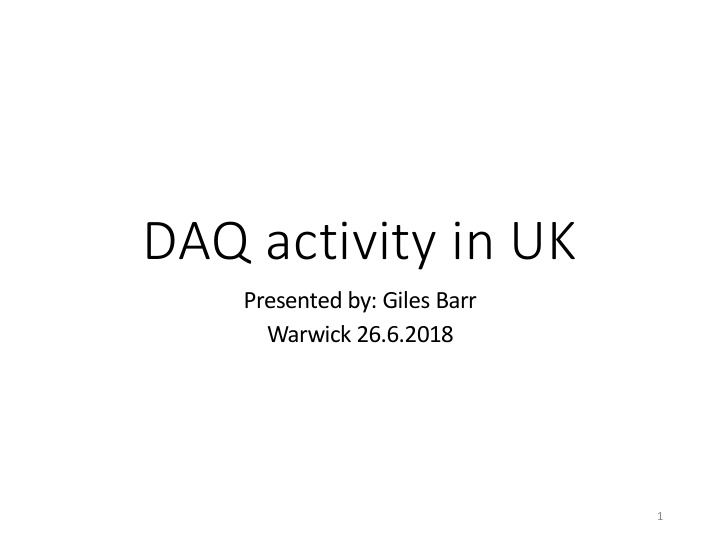



DAQ activity in UK Presented by: Giles Barr Warwick 26.6.2018 1
Brief overview • ProtoDUNE DAQ • [Jennifer Haigh talk soon] • Performance studies • [Phil Rodrigues talk soon] • Consortium + Architecture etc. • [Simon Peeters talk just now] • Prototyping, preparation for production in UK • [this talk] 2
ProtoDUNE DAQ [ See talk by Jennifer Haigh] Much progress: • UK provided • Hardware for timing • Software for photo-dets, trigger, timing • Computers, disk-storage • Online monitoring framework and plots • Was ready for cold-box testing of APAs • Stable runs with all components together • Triggering and timing commissioning in progress Looking forward to beam 3
Performance studies [See also Phil R talk next] Supernova burst detection is a unique challenge for DAQ. • Required to take all the data • Algorithm studies in full swing The architecture is well fixed and agreed. There are small optimizations for cost and to fit the skills of other consortium members still ahead. The part that takes lots of time is filtering noise and hit finding. How can this be done in real-time? [Phil R. talk next] 4
Overall DAQ design Off detector readout systems Detectors’ Electronics Trigger Farm Data summaries Ring Buffer Data Processing Farm Zero suppression and compression occurring at different stages of the DAQ, depending on trigger type. 5
Overall DAQ design [From Simon's talk just now] 6
Overall DAQ design Front-end DAQ UK hardware FELIX Back-end DAQ FNAL & UK real-time software 7
Hardware development (Front-end DAQ) • Evolution from ProtoDUNE DAQ • UK hardware development • Prototype DPM design progressing well; first prototype nearly ready for submission, precursor to cost- optimized final design. • Plans for carrier board prototype. 8
Fi Firmwar are development • 10 second buffer in DRAM • Collect enough data to decide if SN • Look back before trigger fires • Solid-state storage for > 100s of data if SN trigger Diagram – Babak Abi To Back-end Trigger Com m and Data Selection 9 David Cussans | DAQ Firmware meeting, RAL 31 st May 18
Ma Main hardware deliverable: Front End DAQ FP FPGA: Compression + Fi Filter & Hit finding + buffering PS DDR4 PL DDR4 Optical link Samtec 'flyover' m2 nvme 322mm PS DDR4 PL DDR4 m2 nvme MTP to LC multi- fiber breakout cable Commercial form-factor alternative 10
Overall DAQ design Front-end DAQ UK hardware FELIX Back-end DAQ FNAL & UK real-time software 11
Software for backend DAQ The main framework is artDAQ • The artDAQ group is flexible in what can be added and has added many features for ProtoDUNE There is plenty to do, some very interesting for software experts. E.g. • Real-time trigger hit delivery mechanism • Global trigger and data flow orchestrator design • Error recovery: top-down design/policy • Subscription run-control/partitioning model Working effectively with many-core DAQ machines and fast- networking. Increasing data collection reliability 12
Software design studies (Back-end DAQ) Main challenges: • DUNE receives >1TB/s • Much smaller physics trigger rate, but high efficiency needed. • Find hits locally • Centralize final decisions • Ongoing study on software architecture progressing rapidly 13
UK activity Pre-construction grant: Planning for construction grant • ProtoDUNE • Front-end DAQ [Big] • Hardware/Firmware [Big] • Back-end DAQ [Big ish ] • Simulation and triggering • Timing system • Architecture • Testing, facilities & ops • Test stands • Simulation and performance monitoring 14
Summary Many activities ongoing: • ProtoDUNE has been the major focus so far and is going well • UK Prototyping projects have been well placed to supply the main DAQ for DUNE. • Custom hardware board (including cool SLAC SSD idea) and back-end software are main pieces of work going forward. 15
Backup 16
DAQ – super-brief introduction • Two caverns (either 1 x APAs, 1 x DP or 2 x APAs) + photon detectors • Beam and calibration events at predictable times • Continuous triggering for cosmic, atmospheric neutrinos, NDK, SN-relic, etc... • O(1 drift) readout non-zero suppressed • Special trigger for a supernova burst. Copy information for many seconds to local SSD drives (non zero- suppressed) 17
Recommend
More recommend